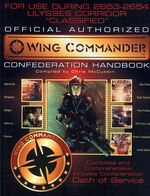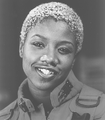Pilot Reviews: CS Tiger Claw
| Pilot Reviews: CS Tiger Claw | |
|---|---|

| |
| Book | Wing Commander Confederation Handbook |
| Previous | Pilot Nose Art |
| Next | Marine Boarding Protocol |
| Pages | 63-69 |
Text
Final Evaluation, Lt. Christopher Blair
SCREEN 1 | query “lt blair, cs tiger claw” media=archives/confid level=CONFIDENTIAL | source=TCSF Flight School, SIRIUS, 2654
CSF FLIGHT SCHOOL
To: Captain Sansky, CS Tiger Claw
From: Major E. Gonsalas, C.O. 145th Training Wing, CSF Flight School, Sirius
SIR,
It is privilege to report that Lt. Christopher Blair has graduated Fighter Pilot training with Distinction, as a member of the Q1 class of 2654, and has been assigned to your vessel’s Fighter Squadron. As Lt. Blair’s flight instructor, I have prepared the following summation of his capabilities.
ACADEMY RECORD
GPA 3.64 Rank in Class 477 (of 1403)
Flight School Academic Record
GPA 4.22 Rank in Class 23 (of 314)
Flight School Flight Record
Flight 96.2 Rank in Class 1 (of 314) Marksmanship 93.4 Rank in Class 2 (of 314) Safety 100 (0 accidents, 0 ships lost) Rank in Class 1 (of 314) Navigation 100 Rank in Class 1 (of 314)
STRENGTHS
- Astonishing control and discipline in the cockpit.
- Deep sense of personal ethics.
WEAKNESSES
- Independent thinking may lead to the appearance of questioning orders.
- Sensitive to comments about his family. Blair is an orphan, and inappropriate remarks about his parents may lead to tension, particularly under battle pressure.
SUMMATION
Lt. Blair is simply one of the most gifted young pilots I have ever trained or flown with. His composite flight score (97.4) is a new record high among pilots coming to Flight School directly from the Academy. Furthermore, he is the first graduate of this institution to ever achieve a perfect score in Navigation. In flight, Blair is confident, focused, disciplined and creative. He understands teamwork, but performs best when allowed to take the initiative.
Blair is reserved among others, but when he speaks up at all he tends to speak his mind. He does not welcome personal questions. Although not a natural leader, his talents in flight point to strong leadership potential within a flight unit. He accepts criticism well when it’s directly related to performance of his duties. Blair will do best in an environment where policies are clearly set forth, but pilots are allowed a reasonable degree of mission autonomy.
ADDENDUM
Since Lts. Blair and Marshall are both being assigned to your ship (as per my recommendation) I am attaching this addendum to both pilots’ evaluations.
In training, Blair and Marshall were both close friends and personal rivals. They respect and trust one another, and there is little doubt that each brings out the best in the other. In flight, they make a remarkable team, but they do display a regrettable tendency to assume that as a team they are unbeatable, which will need to be beaten out of them if they are to reach their full potential as a flight team.
Both Blair and Marshall are already blooded in combat. During a routine training flight they surprised and destroyed a Kilrathi blockade-runner. During this action against a superior force, both pilots displayed skill, courage and discipline normally found only in more experienced warriors. It is because of this remarkable achievement that I recommended Blair and Marshall be assigned together for their first combat tour.
Final Evaluation, Lt. Todd Marshall
SCREEN 1 | query “lt marshall, cs tiger claw” media=archives/confid level=CONFIDENTIAL | source=TCSF Flight School, SIRIUS, 2654
CSF FLIGHT SCHOOL
To: Captain Sansky, CS Tiger Claw
From: Major E. Gonsalas, C.O. 145th Training Wing, CSF Flight School, Sirius
SIR,
It is privilege to report that Lt. Todd Marshall has graduated Fighter Pilot training with Recognition, as a member of the Q1 class of
2654, and has been assigned to your vessel’s Fighter Squadron. As Lt. Marshall’s flight instructor, I have prepared the following
summation of his current capabilities.
ACADEMY RECORD
GPA 4.02 Rank in Class 125 (of 1403)
Flight School Academic Record
GPA 4.50 Rank in Class 9 (of 314)
Flight School Flight Record
Flight 91.1 Rank in Class 2 (of 314) Marksmanship 95.1 Rank in Class 1 (of 314) Safety 100
(3 accidents, 1 ships lost, inquiry found no fault)Rank in Class 311 (of 314) Navigation 88 Rank in Class 22 (of 314)
STRENGTHS
- Extremely gifted, fearless pilot.
- Tremendous talent for finding unconventional solutions.
WEAKNESSES
- Takes unnecessary risks. Tends to trivialize personal danger.
- Doesn’t always know when to shut up.
SUMMATION Lt. Marshall is a pilot of infinite promise. His Flight and Marksmanship scores, as well as his classroom grades, are exemplary. In flight, Marshall is aggressive, creative and committed. Although cleared of any charges in the three accidents he was involved in during training, Marshall undeniably tends towards a high-risk, seat-of-his-pants flying style. Although his offensive instincts are highly developed, he sometimes forgets that his wingmen may not be as on top of the situation as he is (hopefully this will be less of a factor with more experienced pilots). This is a significant drawback to Marshall’s otherwise excellent teamwork skills. His single biggest drawback as a pilot is a tendency to see combat as a game or challenge, rather than a life-or-death struggle.
Among others, Marshall is outgoing and generally likable, but may create tension with a flash of temper or inappropriate “wit.” He shows tremendous longterm leadership potential, but needs a more mature outlook before being given actual command authority. He accepts suggestions well, but can become defensive if directly criticized. Marshall needs a highly disciplined, structured environment. He needs to fly with experienced, skilled pilots that he can look up to.
ADDENDUM
Since Lts. Blair and Marshall are both being assigned to your ship (as per my recommendation) I am attaching this addendum to both pilots’ evaluations.
In training, Blair and Marshall were both close friends and personal rivals. They respect and trust one another, and there is little doubt that each brings out the best in the other. In flight, they make a remarkable team, but they do display a regrettable tendency to assume that as a team they are unbeatable, which will need to be beaten out of them if they are to reach their full potential as a flight team.
Both Blair and Marshall are already blooded in combat. During a routine training flight they surprised and destroyed a Kilrathi blockade-runner. During this action against a superior force, both pilots displayed skill, courage and discipline normally found only in more experienced warriors. It is because of this remarkable achievement that I recommended Blair and Marshall be assigned together for their first combat tour.
Bi-Annual Pilot Evaluation Lt. Commander Jeanette Deveraux (Callsign Angel) Squadron Commander
SCREEN 1 | query “lt cmdr deveraux, cs tiger claw” media=archives/confid level=CONFIDENTIAL | source=CS Tiger Claw bi-annual pilot eval
CS TIGER CLAW
Executive Office
Commander Paul Gerald
2654.02
PERFORMANCE
As a pilot, Lt. Cmdr. Deveraux has few equals aboard the Tiger Claw. She has a crisp, clean flying style and a thorough understanding of battle situations.
As a commander, Angel has been an exemplary squadron commander, and in my opinion we are fortunate to have her aboard. In the past year, she has single-handedly managed to turn around a defeatist and enervating morale situation aboard the Tiger Claw. When she was promoted to her current duties, the sick time was high, fire-to-hit ratios were low, and the pilot return rate was one of the lowest in the fleet.
At the time of this evaluation, the situation is reversed. Sick leave seems nearly restricted to critical situations, due primarily to ongoing sim contests and maneuver drills. She has taught her pilots the real-world necessity of “book flying” and teamwork.
She’s also led her pilots, by example, to take personal pride in the maintenance of their fighters. Now all ships are competently doublechecked by the pilots. Efficiency ratings in the Repair Pit have doubled in the last six months.
LEADERSHIP
Unlike many commanders, Lt. Cmdr. Deveraux does not use sympathy or camaraderie to inspire her pilots. In fact, many people—including both subordinates and peers—have complained of her “cold demeanor” and lack of compassion. Her methods are effective, however. She drills her people until their skills begin to develop, and never misses the opportunity to provide positive reinforcement for improvement. The fact that she is also quick to reprimand, and has a scathing wit to aim at anyone who doesn’t work up to his fullest potential, provides the sharp “stick” to counterpoint any of her “carrot” compliments.
ACTION POINTS
I am concerned about Lt. Cmdr. Deveraux’s encouragement of the custom that pilots “disremember” any battle fatalities. It may be a way of coping with the high mortality rate, but the captain and I are concerned that it is not psychologically healthy, and it is definitely disrespectful of the final sacrifice these pilots have made.
Bi-Annual Pilot Evaluation Lt. Rosalind Forbes (Callsign Sassy)
SCREEN 1 | query “lt forbes, cs tiger claw” media=archives/confid level=CONFIDENTIAL | source=CS Tiger Claw bi-annual pilot eval
CS TIGER CLAW
Executive Office
Commander Paul Gerald
2654.02
PERFORMANCE
Lt. Forbes is one of the best pilots, possibly the best pilot, aboard the Tiger Claw. She constantly pushes herself to her limits, developing her abilities far faster than regulation sim work and combat drills would permit. Under Lt. Commander Deveraux’s guidance, she has learned the technical aspects of her limitations, and no longer seeks to coax more out of her fighter than it can possibly give her. She has not learned restraint, but at least she has learned what is impossible.
In fact, except for the sim fighter contests, she no longer uses the sim as a practice device. I do not think it an exaggeration to say that she has surpassed what the sim can teach. Recently, Lt. Commander Deveraux has been training her personally, taking her out and showing her the intricacies of teamwork under battle conditions. Her skills have improved markedly, and on more than one occasion she has single-handedly pulled victory from a losing situation.
Her most notable accomplishment in the last six months has been a three-kill mission, where her wing was outnumbered three to one.
LEADERSHIP
Lt. Forbes is very popular with her teammates. Cross-evaluations show that she is regarded as generous and trustworthy. Her gregarious nature and charisma make her a figure that other pilots automatically look to for direction. She has proven to be a popular wing leader. I believe Lt. Forbes has a definite future in command, assuming her attitude continues to mature.
From my own observation, those she has flown with seek to emulate her “flashy” method of flying, often to the point that they damage their craft. When this was pointed out to her, she temporarily flew more conservatively, but then went back to her own unique style. However, she does seem to be encouraging new pilots to learn the basics before trying stunts, and we’ll see if this compromise works out.
ACTION POINTS
Lt. Forbes should be given more command responsibilities, as they become available. She should be encouraged to take the appropriate courses, in preparation for advancement.
Bi-Annual Pilot Evaluation Lt. Ian St. John (Callsign Hunter)
CS TIGER CLAW
Executive Office
Commander Paul Gerald
2654.02
SCREEN 1 | query “lt st john, cs tiger claw” media=archives/confid level=CONFIDENTIAL | source=CS Tiger Claw bi-annual pilot eval
CS TIGER CLAW
Executive Office
Commander Paul Gerald
2654.02
PERFORMANCE Lt. St. John is an above-average pilot who has modest natural ability offset by a truly phenomenal determination. He spends hours in the simulator, practicing maneuvers, honing his reflexes and improving his speed. He seems to thrive under Lt. Deveraux’s command style, responding with equal determination to both praise and constructive criticism.
His response time, however, seems to have reached its maximum limits. That is to say, his best remains unpromisingly slow. He is aware of the problem and has found an interesting way of compensating for it. Hunter sometimes avoids situations that look like they will turn into dogfights, and instead holds back to support his flight from a distance. This method of lying in wait is somewhat unusual, and definitely not regulation behavior for either a wing leader or wingman, but so far it seems to work. His wingmen say they can depend on his cover fire when they need it.
LEADERSHIP
Hunter is not a natural leader, although he can be a supportive peer.
He is quickly swayed by the opinions of his peers, is standoffish to people he has not known long, and can be scathing in his opinions of his comrades. His sense of humor is rudimentary, he has difficulty recognizing sarcasm, and he has a history of picking fights with colleagues he feels are laughing at him. It is worth mentioning that since he has started pushing his flying abilities to their limits, he has become less belligerent.
As his abilities and self-confidence improve, he may have time to work on his interpersonal skills, but until then he will remain unsuited to command assignment.
ACTION POINTS
Lt. St. John should have a complete physical to determine if his reflexes are slow due to medical reasons.
Lt. St. John should, once he achieves his Aclass rating, be urged to take CDI training; Interpersonal Conflict Resolutions and Anger Management, in particular.
Bi-Annual Pilot Evaluation Lt. Adam Polanski (Callsign Bishop)
SCREEN 1 | query “lt polanski, cs tiger claw” media=archives/confid level=CONFIDENTIAL | source=CS Tiger Claw bi-annual pilot eval
CS TIGER CLAW
Executive Office
Commander Paul Gerald
2654.02
PERFORMANCE Lt. Polanski is a skilled front-line pilot, with experience on several carriers and with several varieties of fighters. He is an equally competent wingman and wing leader, able to calmly give or receive orders under fire.
Of particular value is his ability to design and implement battle tactics based on visual, scanner and command-ship communication. He has a firm grasp of how Kilrathi react to different situations, and has on one notable occasion turned the tide from failure to victory, based solely on heat-of-battle calculations.
On another occasion, he was able to lead five pilots in a controlled retreat, bringing them in safely from an asteroid-field ambush. Decoration for this action is pending.
LEADERSHIP
Although he has only been on the Tiger Claw for three months, I have had to change my opinion of Lt. Polanski several times already. At first he seemed too open and optimistic, and I was concerned that he would not be up to the daily tragedies of front-line battle. It then turned out that was a temporary front, brought on by the stresses of adapting to several new environments in succession. He is in fact a quiet man, inclined to introspection.
His peers respect him, but do not yet feel they know him.
All in all, he is an excellent officer, and could go in any direction that interests him, subject to the needs of the service. My personal suggestion would be Command and Control, although he would also be an excellent flight officer or trainer.
ACTION POINTS
He should decide what direction he would like his career to proceed, and be given responsibilities in light of that decision. He should be assigned the position of wing commander as often as feasible, and encouraged to debrief after each mission with a eye to the overall war effort.
Bi-Annual Pilot Evaluation Lt. Joseph Khumelo (Callsign Knight)
SCREEN 1 | query “lt kuhmelo, cs tiger claw” media=archives/confid level=CONFIDENTIAL | source=CS Tiger Claw bi-annual pilot eval
CS TIGER CLAW
Executive Office
Commander Paul Gerald
2654.02
PERFORMANCE Lt. Kuhmelo’s ability as a fighter pilot is actually much greater than would appear from his kill score or personal goal success. Statistically, he looks to be one of our poorer pilots, but in fact, I’d be inclined to argue the opposite.
I have been made aware that a great deal of his time in the cockpit is spent “coaching” the raw pilots. He has talked at least two pilots through their first kills, and that could not be done by someone who does not have a thorough understanding of both his ship and his enemy.
He has among the highest scores in the sim, and is a popular partner in the team exercises. His low kill score could be due to “giving” his kills away, but actually I am more concerned that he may be hesitating to kill for personal or philosophical reasons.
He has a personal affinity for bombing missions, and is currently at the top of the Broadsword flight roster.
LEADERSHIP
Knight is well-liked by his peers, respected by his superiors, and known by name to most of the other divisions of the ship. His opinions are given full consideration, and he readily accepts the advice of others. He admits when he is wrong, and does not seem to hold grudges against anyone he works with. He has been known to “herd” panicked pilots back to base, during times of radio silence. He has a deep concern for wingmen who are in over their heads.
Once again, my only concern is his low kill score. If he does not fully support the war effort, he obviously cannot be promoted beyond his current status. Any doubts that continue to exist may begin to fester, at which point it would be dangerous to entrust him with command decisions.
ACTION POINTS
Lt. Kuhmelo should be encouraged to continue training new pilots.
He should talk to a ship’s counselor to discover if there are any pre-set prejudices against combat or the role of a fighter pilot.

















